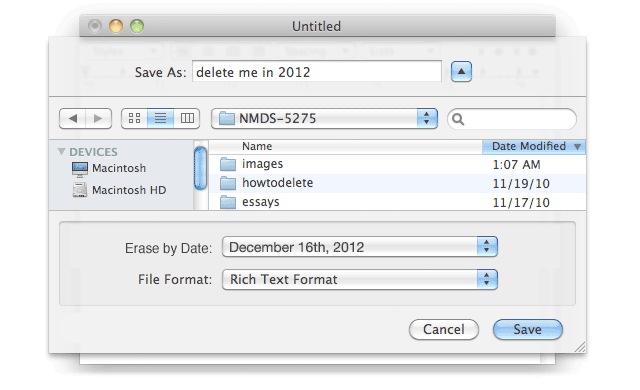
What if you were asked to set an expiration date for every file you saved on your computer? Imagine what would take place on that date. Your file would be automatically erased from your computer and anywhere else that it is stored. Viktor Mayer-Schönberger presents this idea in Delete : The Virtue of Forgetting in the Digital Age, a book that maps the changing landscape of human memory patterns on to the features, practices, and problems of digital storage and online sharing.
Permanence is the bias of information technology – “the net never forgets.” To Mayer-Schönberger technology has evolved from medium to medium to the detriment of forgetting. Forgetting is natural. Human evolution has not entailed an estimable promotion of the neurological capacity to remember. The virtue of forgetting is guaranteed by the mechanism of human evolution. If memory was key to human survival, the faculty would have evolved. The social consequence of this is mapped to familiar stories: a teacher fired for a compromising photo found on myspace, a social scientist denied entry to the United States for an admission of narcotics usage in a paper found by US Customs on Google, Dutch Jews identified and easily located by the Nazis through the detailed record keeping on all citizens by their government. Haunting stories of data permanence, information recalled out of context and stored out of control.
The ability to appropriate information without trace of original context is a digital affordance that must be programmed out of technology. Mayer-Schönberger proposes that digital storage devices and the content on them be given expiration dates restoring digital storage into a healthy reflection of the natural human capacity. At the very least the idea prompts users to consider the materiality of their electronic inscriptions.
Certainly there are challenges that may make this idea impossible to implement. First, every new piece of hardware will have to be shipped with instructions to engage in the deletion of files with an expiry date. Getting all manufacturers and software developers to agree with this and upon an effective deletion method will be a unique challenge, altogether different from the implementation of DVD regionalization since it will govern erasing and time keeping not just reading. Secondly, programmed erasure could be triggered by a simple date change on a computer or re-write of the meta data for a file to an earlier date.
Manufactured deletion may become as tiresome as planned obsolescence (coincidentally, both ideas were proposed within a depression: Delete in 2009, Ending the Depression Through Planned Obsolescence in 1932). In Mayer-Schönberger’s brief historical narrative of the technological evolution toward “perfect memory”, a critical distinction is made about how memory is maintained. We can think of memory as a web page. With no links to it, the unit of memory is effectively forgotten. This model of memory is recognizable in how Facebook manages content deletion. Or memory can be viewed as constantly changing as it is recollected and thereby reconstructed into the present under changing conditions. Mayer-Schönberger argues that our selective and “constant reconstruction of our past based on the present” is a virtue if not critical for our survival:
Using generalizations, relying on conjecture, emphasizing the present, and respecting subsequent experiences, helps us to reason swiftly and economically, to abstract and generalize, and to act in time, rather than remain caught up in conflicting recollections. – Mayer-Schönberger, Delete.
But what guarantees the integrity of reconstructions of the past and keeps authority structures in check if not material evidence? Certainly photos or research papers may be taken out of context, but how will that change the will to use that information? Generalizations and conjectures that do not wrestle with the material and how to properly arrange it cannot become conclusions or theorems. Data permanence and the active and attentive pursuit to accurately employ it in a projection of the past on the present may better serve decision making than planned erasure. A study of the impact of decision support systems on organizations ought to make a strong case for a focus on preserving data, modeling it accurately, and recollecting it honestly.
And a concerted effort has to be made keep a link to digital objects active. What is inscribed is not necessarily there for ever, ready at hand. The internet is a network of electronic devices uniquely interfaced, all relying on different operating systems and storage formats. Data on storage devices may be there, readable, maintaining integrity in its format, but the reading devices – cd-rom drives, zip drives, floppy drives, tape drives – their logical modeling environments – operating systems and software packages – and the people that know how to operate it, all these agencies can become scarce, difficult, or expensive to employ in reconstructing digital memory. All combine to create a sense of loss motivating libraries and foundations to archive the web. To save it from an erasure that simply is digital objects taken offline.
